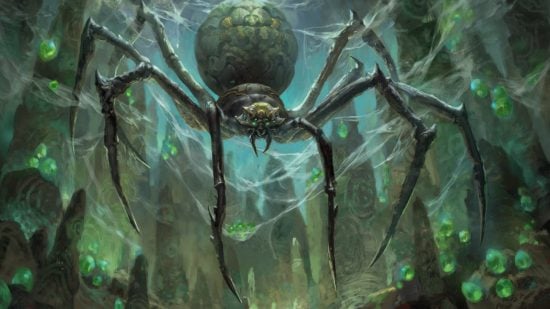DnD’s Poisoned 5e condition represents the shudders and tremors that wrack a character’s body after they’re exposed to a deadly toxin, whether the source is a monster’s bite, a Poisoned weapon, or supernatural magic. This guide explores how Poisoned works; spells that inflict Poisoned; Poisoned weapons; and more.
For more info on the various Conditions that can affect your Dungeons and Dragons character and their effects, check out our Prone 5e, Exhaustion 5e, and Incapacitated 5e condition guides. Alternatively, you can brush up on the fundamentals with our guides to the DnD races, DnD character sheets, and the best DnD character creator tools.
Otherwise, keep your antidotes handy and dig in.
Here’s what to know about DnD’s Poisoned 5e condition:
Poisoned 5e – how does it work?
As long as a character has the Poisoned 5e condition, they have disadvantage on attack rolls and ability checks.
Most poisons, whether they cause the Poisoned condition or not, are resisted by Constitution saves – meaning Fighter 5e and Barbarian 5e characters will have no trouble shrugging off the effects, while the Wizard 5e and Rogue 5e classes are at the mercy of the dice. Dwarves are too sturdy and stone-headed to easily succumb to poison, and have advantage on saves to resist its effect.
The Poisoned condition doesn’t cause poison damage, and receiving poison damage doesn’t automatically poison a character – but the two often come as an unpleasant double-act.
Spells that inflict the Poisoned condition in DnD 5e
There are two key D&D spells that inflict the Poisoned condition, and they’re both the preserve of necromancers. The first level necromancy spell Ray of Sickness causes 2d8 damage and forces a Constitution saving throw, or the target becomes Poisoned until the end of the caster’s next turn.
The fifth level touch attack spell Contagion is far more gruesome. A target hit with the spell is Poisoned, and must make Constitution saves at the end of each turn until they pass or fail three saves.
Three failures will see their Poisoned status mutate into a vile sickness that lasts for a week, with effects ranging from Fleshrot – which makes them vulnerable to all forms of damage – to Blinding Sickness, which gives them disadvantage on Wisdom checks and Saves, as well as blinding them.
DnD 5e Poisoned weapons
DnD 5e Poisoned weapons can be very handy tools for damage dealers – but there are pitfalls too. If a character can acquire poison, either as loot or through shady connections, it takes one action to apply it to a melee weapon or ammunition for a ranged weapon. The first character injured by the weapon must pass a Constitution save or suffer the poison’s ill effects. For Basic Poison, that’s just d4 damage. Our Rogue 5e class guide explains how Assassin characters can double-down on Poisoned weapons.
Brewing poison
Brewing poison is not usually worthwhile – following the basic crafting rules, it takes a character 20 days to brew one dose of that extremely weak basic poison. A character with the Poisoner feat is much more capable, taking just one hour and 50 gp in ingredients to brew a number of doses of a potent poison equal to their proficiency bonus.
Unless the victim passes a DC14 Constitution save, they suffer 2d8 poison damage, and get the Poisoned condition for a turn. To make things worse, a poisoner can apply poison with just a bonus action.
Harvesting poison from monsters
Characters with a proficiency in Nature or the Poisoner’s Kit can attempt to harvest the venom from slain or incapacitated monsters. This takes d6 minutes, has a DC of 20, and is a risky prospect – failing the roll by five or more means the unwary adventurer has exposed themselves to the venom.
Success yields a stable dose that can be applied to a weapon. If your party has slain a mighty Purple Worm, why not treat the party Rogue by harvesting some of its deadly neurotoxin?
Poison-inducing magic items
If you get anxiety about consumable items but still want to join the poison party, consider acquiring the rare DnD 5e magic item Dagger of Venom. The bearer of this +1 magic dagger can spend one action to coat it with a deadly toxin. The first character struck by it in the next minute must pass a DC15 Constitution save or suffer 2d10 poison damage and be Poisoned for a minute. This ability only works once per day, but it’s a fearsome tool to hamper a dangerous but frail enemy – like a Rogue or spellcaster – for the duration of a fight.
DnD Monsters and the Poisoned 5e condition
Many DnD monsters pack a venomous sting, bite, or magical effect, and they start showing up early on in an adventurer’s career. The amphibian Grung secrete venom through their skin, making them one low-level mob that you never want to attempt the Grapple 5e action on.
Every kind of Spider enemy – from lowly critters to the Giant Spider 5e monster – inflicts poison damage with their bite attack, and any character reduced to zero HP by that poison will be Poisoned for a full hour, even if they recover hit points. While they’re Poisoned they’ll also be paralysed.
With their unhealthy relationship to spider-kind, it’s no surprise that many Drow also make use of poison. Their hand crossbow ammunition is laced with a toxin that can inflict the Poisoned effect for a full hour. If the target fails the DC 13 Constitution save against this venom badly enough, they’re rendered fully unconscious. As spindly denizens of DnD’s Elf 5e race, the Drow are no more resistant to their envenomed weapons than the player characters are – but watch out for Drow Priestesses, who can cast the DnD spell Protection from poison.
Almost all constructs, undead, and fiends are immune to becoming Poisoned, which makes sense – poisons have a hard time affecting a creature whose body is already dead, built from cogs, summoned from ectoplasm, or an emanation of pure cosmic evil. Although they’re immune to poison, these creatures can certainly cause it – a Pit Fiend’s bite inflicts a deadly poison that prevents the target from regaining hit points and constantly drains their health.
Source: Wargamer











